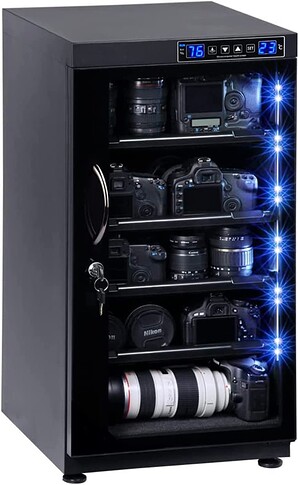What’s the correct humidity level? I use a dry box for my binder and graded cards - similar to the one below.
How I store my graded cards
I double team bag my slabs and put them inside an acrylic box. Then I place the acrylic box inside the dry box. My slabs aren’t expensive, but I want them to be in excellent condition if I gift some away or decide to sell them in the future.
My concern
What is the appropriate humidity setting for my cards? I’ve researched it online, and everyone has a different answer. Some say 30-40%, and others say to keep it at 50% and below (50% seems a little high). What is the precise humidity level I should set for my dry box? I know everyone will have different answers depending on their climate.
Aren’t you doing too much?
You might think putting slabs inside two team bags and then an acrylic box is psychotic, but it makes it easier for me to place the same acrylic container inside a vault when I travel overseas. That is because vaults are useless against humidity and dry boxes are useless against burglars.
What others say
Polygon says 45-55%
“Basic guidelines advise storing between 68 and 72 degrees Fahrenheit as well as at a humidity level of 45-55%. The first step to any of this delicate balancing is in monitoring, and that’s where Polygon’s TCS services become so useful. Remote monitoring offers a portrait of the storage space that shapes the environmental variables. For the most delicate of materials, such as first edition baseball cards , Polygon’s DOC services vacuum-freeze dry environments, achieving the ultimate dry setting for long-term preservation. There are subtle differences between storing organic and inorganic materials as well.”
Leeasher says 30-40%
“Playing Cards prefer a 68 F (20 C) and a relative humidity range of 30%-40%. They can be stored in temperatures as low as 30-40 F (-1 through 4 C), as long as the humidity stays constant between 30-40%. Again, dehumidifiers can reduce the moisture in a room or storage area and are inexpensive.”
Cardcapsule says 45-55%
Card Capsule | Keep Sports Cards in Pristine Condition).
“A dehumidifier will remove moisture from the air and help protect your cards (between 45% and 55% humidity is considered ideal).”
An efour thread has someone saying 40-50%
“…just to chime in on your direct question. From what I read, anything lower then around 50% RH is idea for cards. Anything lower then 35-40% starts to get “dry” that can lead to other issues, cracking, brittleness etc (that is often seen in old paper documents, etc). Case in point, anywhere between 40-50/55% would be my go-to.”
Reddit post has someone saying – “The accepted standard for indoor humidity is 30-50%.”
https://www.reddit.com/r/magicTCG/comments/krusui/experiments_with_humidity_and_foil_card_curling/
“The accepted standard for indoor humidity is 30-50%. As these experiments show, foil cards made in the US are still dramatically curled at 45% humidity. I think customers should reasonably expect playable cards at normal indoor humidities.”
So what’s the correct answer? I am confused.


